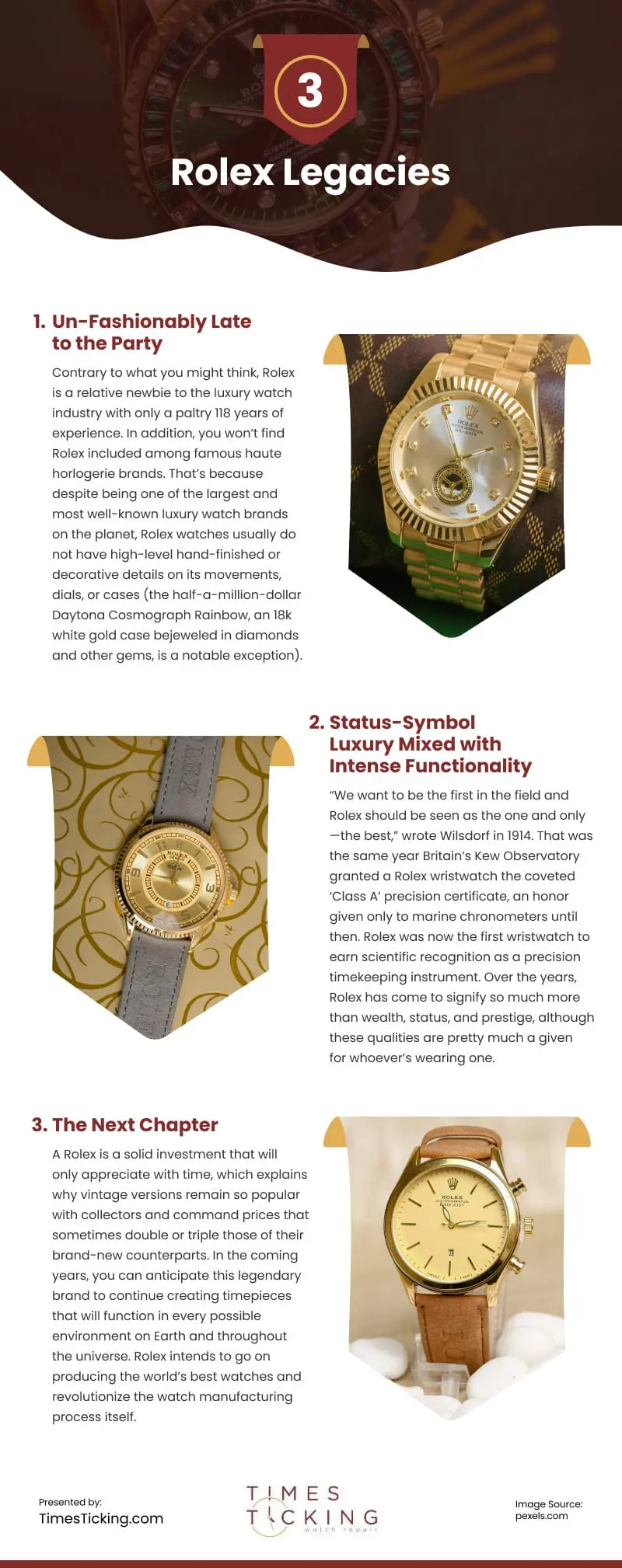
Despite their seemingly museum-worthy elegance and unwavering designs, Rolex watches are a pinnacle of daily luxury wear. Synonymous with premier watchmaking, Rolex stands out as the quintessential icon in the luxury watch industry. This blend of discreet sophistication and durable functionality positions Rolex not just as a maker of timepieces, but as the emblem of timeless luxury.
1. Un-Fashionably Late to the Party
Despite its reputation, Rolex is a relatively recent entrant into the luxury watch market, boasting a history of 118 years. This contrasts with older brands like Vacheron Constantin, founded in 1755, and Blancpain, dating back to 1735. Omega, considered Rolex’s primary rival, precedes it by 57 years. Unlike esteemed haute horlogerie brands such as Vacheron Constantin, Audemars Piguet, Patek Philippe, A. Lange & Söhne, and Breguet, Rolex does not focus on intricate hand-finished details in its movements, dials, or cases—except in rare instances like the Daytona Cosmograph Rainbow. Founded by Hans Wilsdorf and his partner, Rolex aimed to create universally recognized, top-of-the-line timekeeping devices that excelled in scientific and technological innovation.
2. Status-Symbol Luxury Mixed with Intense Functionality
Hans Eberhard Wilhelm Wilsdorf, born in 1881 in Kulmbach, Bavaria, embodied self-reliance from an early age. Orphaned at 12 and growing up in a predominantly Catholic region as a Protestant, Wilsdorf established a successful business in London during World War I, a time of widespread anti-German sentiment. His ambition and passion for watchmaking fueled the rise of Rolex to one of the most prestigious watch brands. The British Kew Observatory awarded Rolex the first-ever “Class A” precision certificate in 1914; this distinction had previously only been given to marine chronometers. This accolade marked the beginning of numerous milestones for Rolex, including the creation of the first waterproof wristwatch (the Oyster, 1926), the first self-winding movement (1931), and the first wristwatch to display the date (the Datejust, 1945), among others. Rolex watches symbolize more than luxury; they represent a blend of high-status appeal and unparalleled functionality, cherished by affluent individuals worldwide, as Wilsdorf had envisioned.
3. The Next Chapter
Rolex’s global fame and the enduring value of its watches suggest that the company is unlikely to alter its approach to sales or production significantly. Producing approximately one million watches per year, Rolex maintains strict control over retail prices and the distribution of genuine parts to ensure high demand, low supply, and consistent product quality. This policy has pushed independent repair professionals to the secondary market for vintage piece restoration. Rolex’s pricing strategy places its watches in a unique position between accessible luxury and unattainable extravagance, with the assurance that each purchase is an investment in precision and durability rather than mere aesthetic appeal. This philosophy ensures that Rolex watches, especially vintage models, remain highly sought after by collectors, often appreciating in value over time. Looking ahead, Rolex is poised to continue innovating in watchmaking, leveraging its internal R&D and state-of-the-art laboratories to craft timepieces capable of operating in the most extreme conditions on Earth and beyond. Hans Wilsdorf’s legacy endures through Rolex’s commitment to excellence and innovation in the world of luxury timekeeping.
source: https://www.timesticking.com/rolex-in-a-league-of-its-own/
Comments
Download this infographic.
